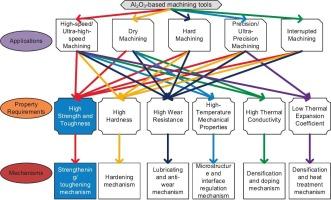铝基陶瓷刀具增韧研究进展
IF 4.6
2区 材料科学
Q2 MATERIALS SCIENCE, MULTIDISCIPLINARY
International Journal of Refractory Metals & Hard Materials
Pub Date : 2025-09-09
DOI:10.1016/j.ijrmhm.2025.107436
引用次数: 0
摘要
氧化铝基陶瓷刀具由于其优异的硬度、耐磨性和热稳定性,在现代机械加工中引起了极大的关注。然而,它们固有的脆性和较差的抗热震性长期限制了它们的广泛应用。本文全面总结了氧化铝陶瓷工具增韧的最新进展,包括相变增韧、晶须增强、石墨烯增强和纳米复合技术。讨论了每种增韧方法的机理、微观组织效应以及由此产生的机械和加工性能。特别强调了ZrO2的相变增韧,晶须桥接和拔出机制,以及石墨烯的多功能增韧效果。此外,重点介绍了纳米颗粒分散和晶界工程在增强致密化和抗断裂性能方面的最新进展。最后,展望了高性能铝基陶瓷刀具在极端切削条件下的发展前景和面临的挑战。本文章由计算机程序翻译,如有差异,请以英文原文为准。

Recent advances in toughening of alumina-based ceramic machining tools
Alumina-based ceramic cutting tools have garnered significant attention in modern machining due to their excellent hardness, wear resistance, and thermal stability. However, their intrinsic brittleness and poor thermal shock resistance have long restricted their broader applications. This review comprehensively summarizes recent advancements in the toughening of alumina ceramic tools through various strategies, including transformation toughening, whisker reinforcement, graphene enhancement, and nanocomposite technology. Each toughening approach is discussed in terms of its mechanisms, microstructural effects, and resulting mechanical and machining performance. Special emphasis is placed on the transformation toughening of ZrO2, whisker bridging and pull-out mechanisms, as well as graphene's multifunctional toughening effects. In addition, recent progress in nanoparticle dispersion and grain boundary engineering for enhanced densification and fracture resistance is highlighted. Finally, future prospects and challenges in the development of high-performance alumina-based ceramic tools for extreme cutting conditions are presented.
求助全文
通过发布文献求助,成功后即可免费获取论文全文。
去求助
来源期刊
CiteScore
7.00
自引率
13.90%
发文量
236
审稿时长
35 days
期刊介绍:
The International Journal of Refractory Metals and Hard Materials (IJRMHM) publishes original research articles concerned with all aspects of refractory metals and hard materials. Refractory metals are defined as metals with melting points higher than 1800 °C. These are tungsten, molybdenum, chromium, tantalum, niobium, hafnium, and rhenium, as well as many compounds and alloys based thereupon. Hard materials that are included in the scope of this journal are defined as materials with hardness values higher than 1000 kg/mm2, primarily intended for applications as manufacturing tools or wear resistant components in mechanical systems. Thus they encompass carbides, nitrides and borides of metals, and related compounds. A special focus of this journal is put on the family of hardmetals, which is also known as cemented tungsten carbide, and cermets which are based on titanium carbide and carbonitrides with or without a metal binder. Ceramics and superhard materials including diamond and cubic boron nitride may also be accepted provided the subject material is presented as hard materials as defined above.

 求助内容:
求助内容: 应助结果提醒方式:
应助结果提醒方式:


